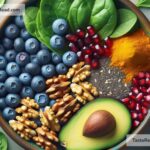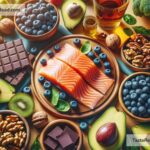Foods for Enhancing Ecosystem Health: Eating for a Better Planet
Our planet is home to many ecosystems—forests, oceans, rivers, grasslands—that keep life on Earth thriving. But these ecosystems are under pressure from pollution, deforestation, overfarming, and climate change. You might think that helping the environment requires big changes, but even the foods we choose can make a difference. By eating wisely, we can support ecosystem health while caring for our own bodies.
This blog explores simple foods and practices that are good for both people and the planet. Let’s discover how eating can become an action for protecting ecosystems and promoting sustainability.
1. Plant-Based Foods: A Win-Win for You and Nature
Plant-based diets emphasize foods like fruits, vegetables, grains, legumes, and nuts. These foods require fewer resources—water, land, and energy—compared to raising animals for meat or dairy. Cows and other livestock produce methane, a powerful greenhouse gas, and their farming often leads to deforestation and soil degradation.
Eating more plant-based foods helps ecosystems by:
– Lowering greenhouse gas emissions.
– Reducing habitat destruction caused by farming animals.
– Saving water (it takes much less water to grow plants than to produce meat).
Some plant-based options to consider: lentils, chickpeas, quinoa, kale, and spinach. Start small by swapping a meat-based dish for a veggie one once or twice a week.
2. Locally Grown Foods Support Local Ecosystems
When you choose locally grown foods—from farmers markets or community gardens—you’re also helping local ecosystems thrive. Large-scale food transportation uses fossil fuels, contributing to air pollution. It can also lead to waste, since foods are piled in giant trucks and may spoil before they’ve reached your plate.
Buying local means:
– Your produce hasn’t traveled thousands of miles, reducing emissions.
– Local farmers are more likely to use eco-friendly practices (since they depend on the health of the soil and nearby resources).
– You’re supporting native plants and animal species that live in your area.
Look for seasonal fruits, vegetables, and herbs. For example, in fall you might find pumpkins, squash, and apples, while summer is perfect for berries and zucchinis.
3. Foods from Regenerative Agriculture
Regenerative agriculture is a farming method that helps rebuild soil health, prevent erosion, and absorb carbon dioxide from the air. Unlike traditional farming, which often depletes soil, regenerative practices involve planting cover crops, rotating crops, and raising livestock responsibly.
Eating foods from regenerative farms directly supports ecosystems. These farms work to restore balance in nature by improving water retention, increasing biodiversity, and reducing chemical runoff into rivers and lakes.
Food grown through regenerative practices often includes:
– Root vegetables like carrots and sweet potatoes.
– Grains such as oats, barley, and millet.
– Pasture-raised eggs and grass-fed beef (if you eat meat).
Look for labels like “regeneratively grown” or ask local farmers about their methods.
4. Seafood Choices: Protecting Oceans
The oceans play a huge role in regulating the Earth’s climate and supporting biodiversity, but overfishing, pollution, and unsustainable practices threaten marine life. By choosing seafood wisely, you can help protect ocean ecosystems.
Here are some eco-friendly seafood tips:
– Choose sustainably caught fish: Look for labels like “MSC Certified” (Marine Stewardship Council) to ensure your fish was caught without harming ocean ecosystems.
– Eat smaller fish species: Sardines, anchovies, and mackerel are lower in the food chain and healthier for oceans because they reproduce quickly.
– Limit problem species: Skip overfished types like tuna or orange roughy, which are at risk of population collapse.
Seaweed is another fantastic choice! It’s a highly sustainable food that grows without fertilizers or freshwater and helps remove carbon dioxide from the air. Make seaweed salads or add nori to soups and sushi.
5. Whole Foods Reduce Waste
Processed foods—like chips, frozen dinners, and candy—often come in excessive packaging that’s harmful to the environment. Additionally, large factories that produce processed items create pollution and waste energy. By focusing on whole foods, you can help decrease the demand for these harmful practices.
Whole foods include things like fresh fruits, leafy greens, nuts, beans, and grains. Buying from bulk bins and using reusable containers can also cut down on packaging waste.
6. Eat to Support Pollinators
Pollinators like bees, butterflies, and birds are vital to healthy ecosystems because they help plants grow and reproduce. However, their populations are shrinking due to pesticide use and habitat loss. By eating foods that rely on pollinators, you show support for these creatures.
Pollinator-friendly foods include:
– Almonds, berries, cherries, and melons.
– Coffee and cocoa (look for organic or fair-trade options).
– Honey (buy from local beekeepers who care for their hives responsibly).
7. Minimize Food Waste
Food waste is a major problem—about one-third of all food produced globally is wasted. This wasted food often ends up in landfills, where it releases methane as it decomposes. By reducing food waste, you’re taking stress off ecosystems.
Here’s how to reduce waste:
– Save leftovers for another meal.
– Compost fruit and veggie scraps instead of throwing them out.
– Plan meals before grocery shopping to avoid overbuying.
Final Thoughts
The food choices we make every day impact not just our health but the health of ecosystems around the world. By eating plant-based foods, buying local, choosing sustainable seafood, and supporting regenerative practices, we all have the power to protect Earth’s biodiversity and natural resources.
Remember, even small changes can make a big difference. Let’s work together, one bite at a time, to build a future where humans and nature thrive side by side.


